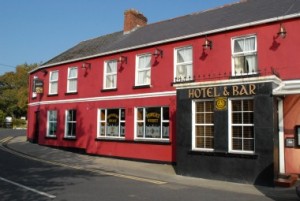Ten years ago, when we first went to the Inishowen Peninsula in Donegal in search of my McDaid family, we stayed in a little town—in Ireland, that’s a redundancy—called Culdaff. Like many Irish towns, it had a couple of churches, a shop, and a handful of pubs, and the one you couldn’t miss was McGrory’s. Set at the bend of the road—sitting nearly on the verge it is the bend of the road—it was and continues to be painted bright barn red, so you couldn’t miss it if you tried. (Given its precarious location, it’s a good idea to try to miss it if you’re driving.)
Technically, McGrory’s is a pub, restaurant and hotel but it’s probably best known in Ireland for luring some of the best and brightest in music to its front bar or back room—from trad musicians Finbar Furey, Altan, Mary Black, Martin Hayes and Dennis Cahill to Richie Havens, Arlo Guthrie and J. D. Souther–since 1924.
We didn’t see anyone famous back then—just a great little trad session in the dark and cozy Front Bar. But we loved the place so much that we ate there every night.
When my husband Ed and I returned to Culdaff a few weeks ago, we popped into McGrory’s for a few meals and a very different kind of session, anchored by the McGrory brothers Neil and John, and a group of local musicians including the Henry Girls, an up-and-coming folk/trad trio of sisters named McLaughlin.
Okay, you’re now thinking, why are they called the Henry Girls when their surname is McLaughlin? A little background: In Inishowen, which is still very wild and remote, certain family names are more common than sheep on a hillside. In fact, when we told a man we met in a Dublin pub that we were going to Inishowen to meet some cousins, he cocked his head and with a gleam in his eye asked, “They wouldn’t be named Doherty, would they?” (They are now, since the last of the McDaids had only one daughter who married a Doherty. It’s Inishowen’s version of “Smith” and the name of a famous and powerful family that traces its roots back to Niall of the Nine Hostages, a fifth century High King of Ireland. About 21 percent of men in Donegal carry Niall’s DNA, likely because he could also have been known as Niall of the Eight Sons. Right now, his DNA can only be traced through the Y chromosome, but many women are also probably Niall’s girls.)
When a place is that small and that remote, the consanguinity factor can be a little disconcerting. My 21-year-old cousin, Maria, who happens to work at McGrory’s, joked that she was so taken aback when a local woman went over every child on her school bus and explained to her how they were related to her that she felt compelled to make sure her boyfriend wasn’t also a cousin.
McLaughlin, likewise, is a very common name. To avoid confusion—or, if you’re an American, to help promote it–families with common names are given a nickname. My Dohertys are the “sean ban” Dohertys, or “old, white” Dohertys. And the McLaughlin sisters are the Henry McLaughlins, hence their name, the Henry girls. This becomes very important when you are sending Christmas cards and want them actually get to the recipient.
Local culture lesson over. On to the music. If you’ve attended an Irish seisun (session) at a local pub, you’ve probably only heard Irish traditional music played or sung. Our experience in Ireland was that there’s more to an Irish session than Irish music. We heard cabaret songs, rock, American country, American western, and even some politically incorrect ditties from a local songwriter.
At McGrory’s Thursday night session (Friday is for trad), we listened to songs from Richard Thompson, Johnny Cash, Blues Traveler, Sam Cook, The Band, John Martyn. . .not the expected fare in a pub with a peat fire blazing, but a warm, wonderful Irish experience nonetheless.
And you can be there since I brought back video. Just a warning—it was very dark in McGrory’s that night. You will not be able to pick the musicians out of a lineup after viewing, so just think of this as McGrory’s Session Radio.

